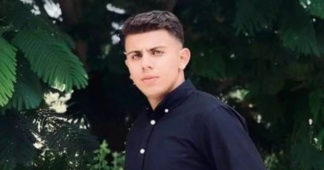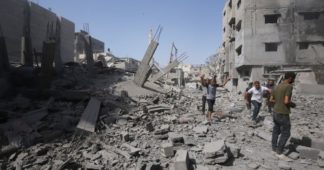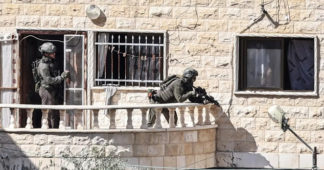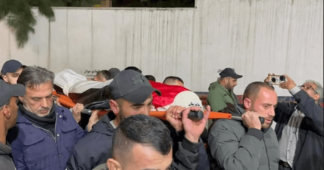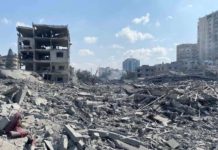Gideon Levy and Alex Levac
Jun 6, 2025
Israeli troops burst into a house in a West Bank village. A soldier fires four shots at a young man who’s asleep in bed. Soldiers grab the body and hustle the shooter outside, and the victim’s brother overhears them asking their comrade: ‘Why did you shoot?’

“Why did you shoot?” soldiers were heard asking their buddy, who had just fired four bullets into a dark bedroom at a young man of 20, who probably didn’t even manage to wake up.
“Why did he shoot?” the father of the deceased demands to know. The father was asleep but woke in a fright at the sounds of soldiers breaking in to the house, which were followed immediately by the shots in his son’s room. The soldiers didn’t let him approach, but he says he saw his son lying on his back, blood spewing out of his shoulder and chest.
Why did the soldier shoot an innocent young man in his bed? This question was also put to the Israel Defense Forces Spokesperson’s Unit this week. The response: “The event is being investigated.” A cold-blooded execution of a young man in his bed – and “the event is being investigated”? Of course, we won’t hear anything about the results of the investigation in the near future, if ever. But in the early hours of Wednesday, May 28, a soldier took the life of a person his age for no apparent reason. Just like that, as if it was nothing.
The troops had forced open the metal door of the house – the damage is still visible. Why, to begin with, did they raid this house and wake up everyone inside in the dead of night? No one in the extended family that lives in the two-story home was a “wanted” person. Moreover, the victim, Jassem al-Sidda, had never been arrested. The village of Jit in the northern West Bank is known for the fact that many of its residents, including Jassem, work in settlements – but of course that didn’t stop settlers from running amok there last August, perpetrating a pogrom in which a villager was killed.
 The al-Siddas’ home this week.Credit: Alex Levac
The al-Siddas’ home this week.Credit: Alex Levac
Jit is located in the Qalqilyah district, east of the settlement of Kedumim. The al-Siddas’ home bespeaks poverty: Four families are crowded into the two floors of this building; there’s a small yard with laundry hanging and firewood stacked up. Jassem, the youngest of five – four brothers and one sister – lived with his parents on the ground floor in a two-room apartment. One brother lives in the adjacent apartment with his wife and children; upstairs are two more brothers and their families.
With its colorful blanket, sheets and pillow case, Jassem’s single bed, standing below a cabinet displaying cheap porcelain knickknacks, was still totally drenched in blood when we visited this week. Dried bloodstains mark where his body lay.
- Weeks later, no one can explain why Israeli troops killed another unarmed Palestinian boy
- These Palestinian fathers have one thing in common: Their sons were killed by IDF troops
- The IDF fired over 20 bullets at a family’s homes. One of them killed two-year-old Laila
Ibrahim al-Sidda, the bereaved father, was sleeping in an adjacent small room and heard the shots, which were fired at Jassem at what was apparently almost zero range. Ibrahim, a short man of 63, bearded and missing a few teeth, does odd jobs; he’s married to Haifa, three years his junior. Haifa wasn’t at home on that terrible night last week. She had slept at the home of another son elsewhere in the village, and so was spared the horrific sights and sounds.
Jassem attended school until seventh grade, when he dropped out to help provide for his family. Until two months ago he worked in a carpentry shop in the Bar-On Industrial Park near Kedumim, and after it went out of business, he worked at jobs in nearby villages. Last Tuesday he worked in Laqif, not far from Jit. He came home toward evening and until 11:30 P.M. hung out with the family in the yard, before going to sleep.

Everything happened very fast. Ibrahim recalls that he first heard the front door being bashed in. It was 1:45 A.M. Almost instinctively he reached for his ID card, which he always keeps under his mattress at night, to be prepared for anything that might happen. Indeed, the lives of Palestinians in the territories cannot go on without having the Israeli ID card of their occupiers at the ready, at any given moment.
Ibrahim was shocked to see that two soldiers had entered his room. An instant later he heard shots from the other room in the tiny, cramped apartment.
Jassem was 20 years and one week old the day he died.
“You killed my son!” Ibrahim cried out to the troops, without knowing for certain at that moment whether his son was dead. The soldiers said nothing, but prevented him from entering his son’s room. Looking past them, Ibrahim saw Jassem lying on his back, bleeding profusely. He screamed and the soldiers ordered him to go to the adjacent apartment – of his son Ihab, 38, who has four children.

Ibrahim al-Sidda, the bereaved father, was sleeping in an adjacent small room and heard the shots, which were fired at Jassem at what was apparently almost zero range.Credit: Alex Levac
As Ibrahim passed the soldiers, he says he heard them shouting “Crazy, crazy!” at the shooter. Another son, Darwish, 37, who lives upstairs with his family, says he overheard the soldiers saying: “Why did you shoot? What, are you crazy? What for?”
One soldier asked the shooter: “Whose body is it?” The soldier said he didn’t know. “You shoot someone without knowing who it is?” his comrade asked. According to Darwish, the soldiers hustled the shooter into a jeep, even before the body of their victim was removed.
Ibrahim begged the soldiers to let him see his son, but the body had been taken by the soldiers. No one informed him that Jassem was dead, but Ibrahim says he was pretty sure he was. He asked to go to the bathroom but the soldiers told him to do it in the yard.
The troops raided three of the four apartments in the building that night, conducting searches. They found nothing and arrested no one. These nocturnal raids and violent, terrifying invasions are often no more than a training exercise for the troops and a way to terrorize the locals.
The soldiers drove the jeep with Jassem’s body toward the village’s exit and subsequently transferred the body to a Palestinian ambulance. The medical report, by Dr. Ibrahim Daoud from Darwish Nazzal Hospital, in Qalqilyah, where Jassem was brought, states that he was dead on arrival.
The physicians found three entry holes and two exit holes in the chest and stomach. The young man had no chance of surviving with three bullets fired at such close range. Shrapnel from a fourth struck his head and the physician also found fractures in Jassem’s left arm.

Members of the al-Sidda family outside their apartment building, where a memorial poster for Jassem is hanging.Credit: Alex Levac
It was at 3:30 A.M. when the IDF informed the Palestinian District Coordination and Liaison Office about Jassem’s death and requested that they dispatch an ambulance to pick up the body. Another hour passed until the last of the soldiers left the village and local residents could once again leave their homes.
As for the al-Siddas, they rushed to the hospital in Qalqilyah to see Jassem’s body, which was already in the morgue. Photographs of him have been hung on the walls of the apartment.
Abd al-Karim Sa’adi, a field researcher for the Israeli human rights organization B’Tselem, arrived at the house at first light, traveling from his village, Attil, in the Tulkarm district, which is quite a distance away.
Sa’adi relates that he saw blood smeared on the wall in Jassem’s bedroom and on the sheets. Based on his examination of the bloodstains in the room, he has no doubt that Jassem was shot while lying in his bed. The fact that no one in the house heard Jassem say anything seems to indicate that he never woke up and was indeed executed in his sleep.
Later on that same Wednesday morning, Jassem was buried in Jit’s cemetery.
We remind our readers that publication of articles on our site does not mean that we agree with what is written. Our policy is to publish anything which we consider of interest, so as to assist our readers in forming their opinions. Sometimes we even publish articles with which we totally disagree, since we believe it is important for our readers to be informed on as wide a spectrum of views as possible.
